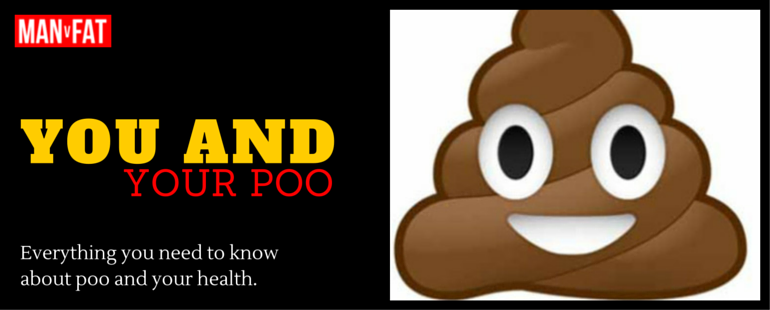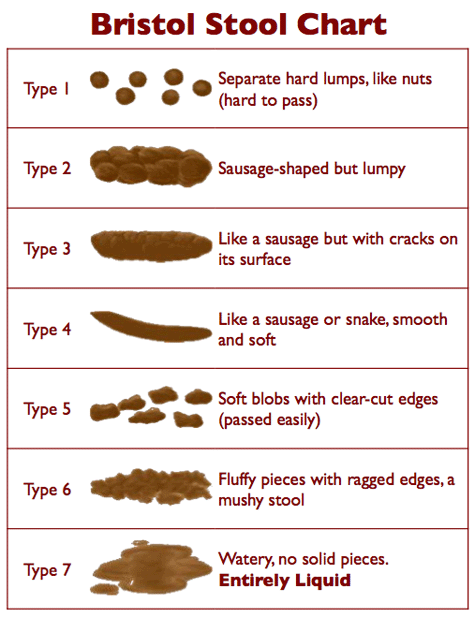Please note, this article deals with the topic of poo. You might not want to read this as you sit down to tuck into a sausage butty. As unsavoury a topic as poo might be, it’s also an incredibly useful tool to tell you more about your health. In short, you need to get on more friendly terms with your stools.
***********
“And have we moved our bowels today, dear?” trilled the nurse for the umpteenth time the other day.
“Indeed we have”, grumbled Grandad.
“And?”
“Twice round the pan … and pointed at both ends.”
Well, at least he’d checked.
Why poo is important
We are told, by those who know such things, that the average person spends about three years of their life producing about five tons of poo. But unlike our feline and canine friends, who do a quick visual and take a big sniff at what they’ve just produced before starting to cover it up, the average Joe just tends to wipe their bum afterwards, pull up their trousers and get on with their life.
And that’s not just a mistake – it could well end up being a fatal error.
Here’s why: Hippocrates (he of the doctors’ oath) stated that all disease begins in the gut, and what better way of checking up on what’s going on in there than by checking what comes out?
What is poo?
On the whole poo is around 75% water (ideally), plus undigested material, gastrointestinal bacteria, bile, dead blood cells, toxins, acids and all sorts of other stuff the body doesn’t want or need any more, all coated in a mucus lubricant to help ease it all on its way out.
What can your poo tell you about your health?
There’s a whole heap of variables involved here: frequency, consistency and colouration. Each of these variables tells some kind of tale, so let’s start with frequency.
It’s not quite a case of going the more often the merrier, but it’s definitely a case of the longer you hold it in, the more effort you’re going to need to get it out, because your intestines will have absorbed enough water from the poo in there to make its texture too hard and dry to slide out easily and comfortably. And that’s what it should do – as opposed to cannonballing into the pan and bringing on Neptune’s infamous Kiss.
The resultant straining brought about by overly dry poos can bring on haemorrhoids, which, if you’ve had them before, you know you don’t want to have them again. If you’re lucky enough not to have suffered from them up to now, well, you’re just plain lucky.
And while we’re on the subject of texture and consistency, those nice people at the University of Bristol developed what the more prissy among us would refer to as the “Meyers’ Scale”, which the rest of us would call the Bristol Stool Scale as we blu-tack this chart to the bathroom wall.
Basically the scale lists seven types of poo – from strain … to smoothness … to splat.
Type 1 stools are the driest, most solid, most difficult and most uncomfortable to expel. Type 1 stools are actually very similar to hazelnuts in consistency, if not size. A sure sign of very serious constipation.
Type 2 stools also indicate constipation. I’d probably be facing a lawsuit if I described exactly which popular confectionary bar Type 2 stools resemble, but suffice it to say they’d be sausage-like to look at … but very lumpy on the outside. Experts say that this kind of poo indicates constipation that’s toxic, and therefore demonstrating a need to flush out the intestinal tract.
Type 3 stools – similar to sausages but with cracks in the surface – are indications that they’ve stayed in the digestive system somewhat longer than absolutely necessary. Those cracks are caused by hardness brought on by a lack of moisture. And that’s the key to a nice smooth movement: moisture. A very good way of smoothing things out is to drink more water.
Type 4 stools are what we should be aiming for: soft, smooth, dropping gently and sinking slowly to the bottom of the pan. No cracks, no lumps, no hazelnuts.
Types 5, 6, and 7 go from partially solid to totally fluid, in – using banking terminology – increasing degrees of liquidity.
This end of the scale indicates that – for the time being, at least – all is not well in the digestion department. It could be due to anything from a bad pint to a dodgy takeaway from a late-night kebab van, if it only lasts for a day or two, but if it persists it could also be an indication of something a lot more serious.
Let’s finally move on from consistency to colour – perhaps the biggest and best indicator of your general health. Ideally, you should be looking for something that’s medium to light brown – the ideal colour for such matters, all things considered. However, your poo could be any number of shades and colours, which would be your digestive system’s way of letting you know all is not well in that department. Or anywhere else in your body.
Health conditions your poo might be telling you about
This is where colour of poo comes in useful. Black poo, for example, might just be an indication that you’ve gone a bit heavy on the old medications or health supplements recently … or that you’ve been indulging in a bit more liquorice than absolutely necessary … or, on a more serious note it could indicate bleeding in the gastrointestinal tract – especially if your poo is similar to tar in both colour and consistency. That would be your cue for an urgent visit to the GP.
So is yellow poo – common in infants, perhaps, but not that brilliant now we’re out of nappies. This could indicate a problem with the liver or gallbladder, giardia infection – an infestation of parasites in the intestines – coeliac disease or Gilbert’s Syndrome which, although considered harmless in itself, could give rise to concerns about a liver or blood condition.
When it comes to poo that’s white, gray or even silvery, and you don’t recall guzzling down heaps of antacids which can cause that colour change, then there’s the possibility of cirrhosis, hepatitis, disorders in the pancreas or even a blocked bile duct – none of which is particularly pleasant, and all of which call for a doctor’s appointment. And fast.
On the bright side, if you discover your poo’s suddenly turned green it’s quite likely that you’ve been stuffing yourself with more leafy veg than usual … or your food’s been moving too fast through your digestive system … or you’ve ingested some pretty powerful food colouring.
So now you know why it’s a mistake – or maybe even a fatal error – not to sneak a quick peek at your poo before breaking out the bumwipe: after all, if all disease really does start in the gut, you’re not going to get a better view of what’s going on in there than by sneaking a peek at what’s just come out.
And that’s why Fido and Tiddles turn round and check out what they’ve just produced, just like Grandad and just like you should.





